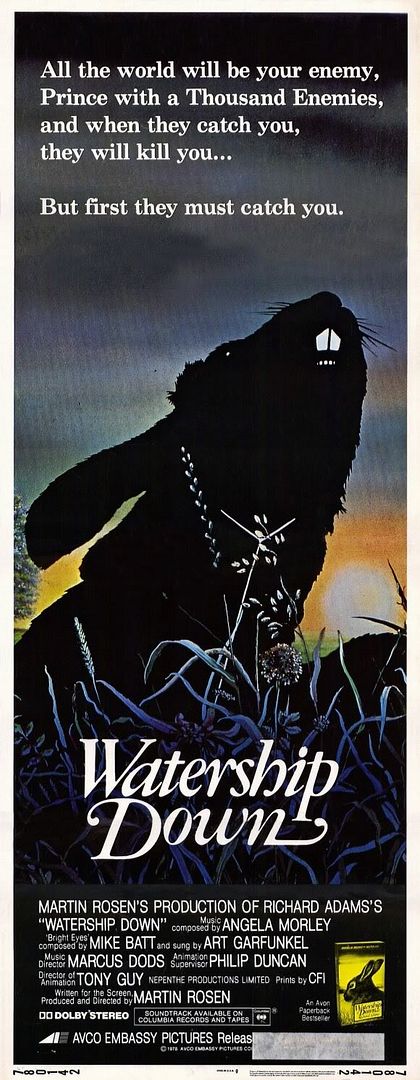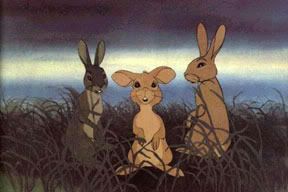 |
| Fig. 1 Watership Down poster. |
Watership Down has always been seen as a children's book. Written by British author, Richard Adams, it is a tale of the extraordinary lives and adventures of a group of rabbits. However, the film carries some very mature themes and imagery that were perhaps not found in the book.
 |
| Fig. 2 Fiver and Hazel. |
During the film, the audience is following a small group of rabbits that have narrowly escaped their almost certain deaths at the previous warren. This was thanks to the unusually quirky young rabbit called Fiver. He and his brother, Hazel are the main protagonists of the narrative. However, one of the reasons the rabbits are so compelling to watch is that they are voiced by wonderful British actors, such as the wonderfully talented John Hurt, as well as having well written ad likeable personalities. Mary Trim explains that the characters, "In an ever rabbit way, they reflect human superstitions, struggles, hope and determination to survive against destructive elements. The characters are memorable: sensitive and clairvoyant Fiver, strong and aggressive Bigwig, witty Bluebell, hateful Black Rabbit who causes sickness and death, and the ever authoritative Hazel." (Trim, 2005: 121) These characters, at first glance, are just rabbits. With very few visual differences, they could easily be forgettable, but as Trim mentions, they are still memorable. Their character traits, such as Bigwig's 'strong and aggressive' demeanour means that the audience always know that they, and the characters can rely on him to protect those that need it.
 |
| Fig. 3 Barbaric Woundwort. |
Another reason the characters, and narrative, manages to be so gripping is the depiction of the struggles and their consequences that the rabbits have to live through. Colin Manlove expressed that "Adams gives us a group of wild animals gripped by the imperative of survival, and a pastoral landscape bristling with threats, mostly from man. Death is always close, and reproduction its only answer: both these topics were unusual in children’s fiction before this time." (Manlove, 2003: 122) Due to this being a work of children's fiction, it would commonly be thought that it would be too simple for an adult audience to enjoy. The lives of these rabbits though, are very similar to that of a struggling family, fighting everyday obstacles in order to get past each day. However, these rabbits are faced with their own mortality, they are hunted and unintentionally killed each day either by farmers or wild animals. These themes of death an violence really do make this an unusually mature piece of children's fiction. Jerry Beck goes on to divulge that "The film is brutal at times, as is the book, not skimping on blood, and actually inserting two additional (and largely unnecessary) deaths not included in the original text. " (Beck, 2007: 307) Not only are these rabbits faced with threats from outside sources, but they are even fighting threats from other rabbits. One example, as seen in figure 3, is Woundwort. This rabbit is violent and quick to hurt any other rabbit that should challenge his authority. There are scenes in which this rabbit claws Bigwig, and another where it tears at another's throat. These images, mixed with the very unsettling flashbacks from an exhausted and hallucinating rabbit, make for some very challenging and mature imagery for children.
Despite its quite disturbing imagery, and the fact that it is seemingly about rabbits, Watership Down is in fact a very engaging and refreshing example of British animation. Its solid voice casting and washed out colour palette really add to the tone of desperation and struggle that these characters are enduring, all in order to reach their safe-haven. It was definitely the voice acting from John Hurt that makes it a 4* film though, excellent stuff!
Figure 1. Watership Down (1978) Watership Down poster. At: http://204.244.128.121/assets/product_images/1020/313506.1020.A.jpg (Accessed: 17.04.12)
Figure 2. Watership Down (1978) Fiver and Hazel. At: https://blogger.googleusercontent.com/img/b/R29vZ2xl/AVvXsEjfGCJtOM18iMaBHFmQ4hYGYv4liGhWsZvwBhTcA8md4i5pEsr16lmzuUwzqK0q9u8UMil9zG0k9jQLIUnWnuTHQSdeJvoz0Zw1mZigLq9CUkKx95SqYJTCmpowoSbrL73jGV3ztwmdadG5/s400/Watership+Down+Pictures.jpg (Accessed: 17.04.12)
Figure 3. Watership Down (1978) Barbaric Woundwort. At: http://www.pastemagazine.com/blogs/lists/2008/12/15/watership-down.jpg (Accessed: 17.04.12)
Bibliography
Beck, Jerry (2007) Animated Movie Guide : The Ultimate Illustrated Reference to Cartoon, Stop-Motion and Computer-Generated Feature Films. USA: Chicago Review Press
Manlove, Colin (2003) From Alice to Harry Potter: Children's Fantasy in England. New Zealand: Cybereditions Corporation.
Trim, Mary (2005) Growing and Knowing : A Selection Guide for Children's Literature. Berlin: K.G. Saur.


No comments:
Post a Comment